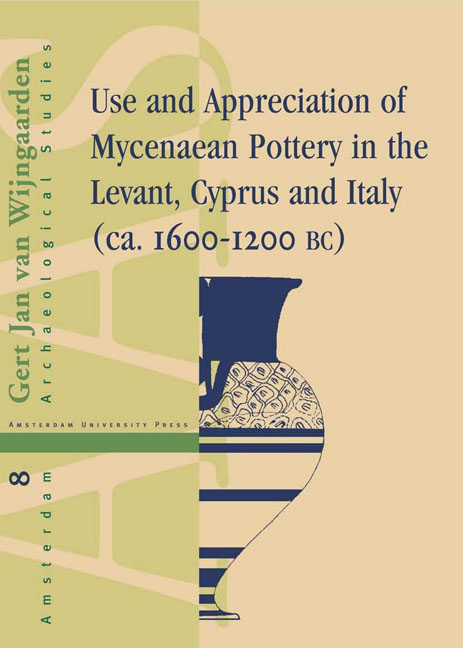8 - The Cultural Significance of Mycenaean Pottery in the Levant
Published online by Cambridge University Press: 10 February 2021
Summary
INTRODUCTION
The detailed contextual analyses of the Mycenaean pottery at Ugarit, Hazor and Deir ‘Alla enable a discussion of the use and appreciation of Mycenaean pottery in the Levant in general. The evidence from other find spots of Mycenaean pottery in the Levant will be discussed here in order to check how representative the conclusions reached for Ugarit, Hazor and Deir ‘Alla are. Before discussing the social groups in the Levant who used Mycenaean pottery, their appreciation of different parts of this class of material and its social significance, I will briefly comment on the repertoire of Mycenaean pots and figurines itself.
MYCENAEAN REPERTOIRE
From the preceding chapters it has become clear that Ugarit has yielded a wider repertoire of Mycenaean pottery than Hazor and Deir ‘Alla. The large quantity of Mycenaean vessels at Ugarit is paralleled only at other coastal cities. From Tell Abu Hawam (site no. 175) some 700 Mycenaean finds have been reported. Excavations in a very limited area at Sarepta (site no. 162) produced some 130 Mycenaean finds, while a nearby tomb had earlier yielded another 67 Mycenaean vessels. The variety of Mycenaean vessel types at Ugarit is paralleled only at Tell Abu Hawam, where a similar range of storage and dinner vessels have been found, as well as rhyta and Mycenaean figurines. Another similarity between these two sites is the predominance of dinner vessels. Ashdod (site no. 222), also a coastal settlement, is the only other site in the Levant with a majority of Mycenaean dinner vessels. At all other sites storage vessels are more frequent. This is also the case at Sarepta, which has yielded a great quantity of stirrup jars in particular. A conical rhyton, a wide range of cups and bowls, as well as female, bovine and chariot figurines testify to the varied character of the Mycenaean repertoire at Sarepta.
It appears that the repertoire of Mycenaean vessels and figurines is generally larger and more varied at coastal centres than at inland sites. Such a distribution pattern has been explained by suggesting a model of the circulation of Mycenaean pottery involving ‘ports of trade’.
- Type
- Chapter
- Information
- Use and Appreciation of Mycenaean Potteryin the Levant, Cyprus and Italy (1600-120O BC), pp. 109 - 124Publisher: Amsterdam University PressPrint publication year: 2002



